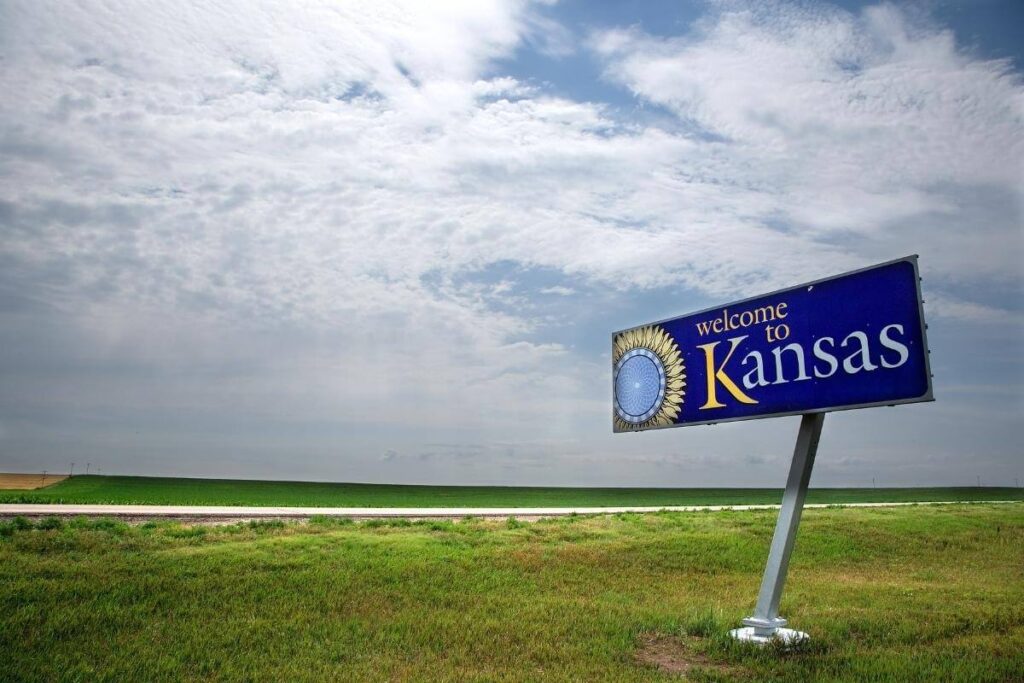
Living or visiting Kansas and wondering what bird you’re looking at? This article covers the most common birds of Kansas. Odds are high the bird you’re looking at is one of them. It will also inform you on how to identify them.
Kansas is known for wheat fields, tornadoes, and as the home of Dorothy. Who would expect it to have 460 different species of colorful birds? However, Kansas happens to be a major stop for migrating shorebirds in both the Quivira National Wildlife Refuge and the Cheyenne Bottoms Wildlife Areas. Kansas is the 16th birder state out of 50.
Not many people realize how diverse this land of wheat fields actually is. The eastern part is by the Ozark Plateau, with its rain and hardwood forests, while the western region is the high plains prairie with very little rain.
Quivira National Wildlife Refuge is one of the prime birding habitats in the U.S. Thousands of migrating waterfowl, waders, and shorebirds come here to nest. Among the migrants is the Whooping Crane, a bird perhaps not associated with Kansas. The Refuge is an avian wetland dream with its ponds, marshes, and grassland.
There is a five-mile route through Quivira made for birding, with its observation tower and parking spots by the roadside. There are several trails from which to choose: the .2-mile Birdhouse Boulevard Nature Trail; the handicapped accessible (half of the trail) 1.25 Migrant’s Mile Nature Trail; the .3-mile Little Salt March trail; and the 5-mile Wildlife Drive.
During the spring and fall, Quivira is inundated with geese and cranes; the summer brings White Pelicans, herons, ibises, and egrets.
The 28,000-acre Cheyenne Bottoms Wildlife Area is another important migratory resting place. This is a favorite stop for the Stilt Sandpiper and Baird’s Sandpiper. The Kansas Wetlands Education Center on Highway 156 is near Cheyenne Bottoms and has plenty of birding information.
The 1,600-acre Shawnee Mission Park is a bird-friendly mix of wetland, forest, and grassland, making it a welcome home for 260 bird species. Here, herons, orioles, the Scissor-tailed Flycatcher, and others build their nest. Waterfowl come here in the spring, and it’s a regular stop for the Bald Eagle.
The Baker Wetlands south of Lawrence sees an abundance of geese, ducks, and wading birds or shorebirds in the fall, with Bald Eagles soaring throughout the year. If lucky, birders may spot 14 different types of gulls.
Common Birds of Kansas
Red-Winged Crow
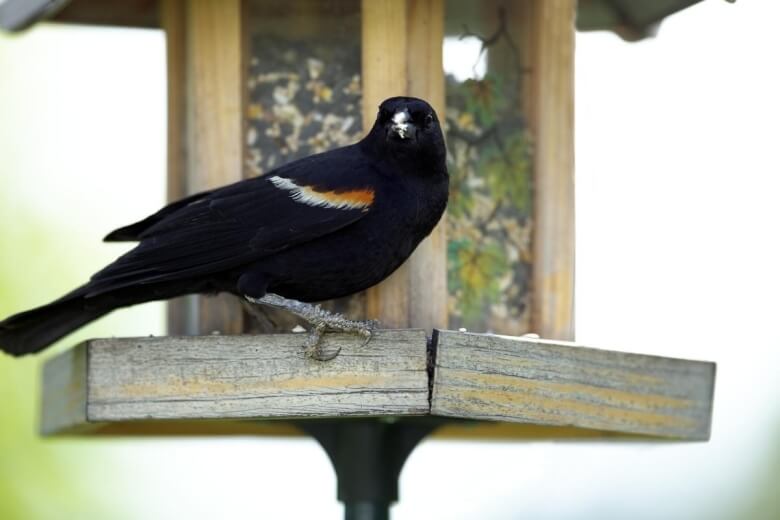
The Red-winged Crow is easily spotted in the marshlands of Kansas. This broad-shouldered blackbird has a conical bill and a medium-sized tail. The male is easy to recognize not only by the glossy black body, but by the red shoulder patches with yellow trim.
The female, brownish with white streaks all over and white eyebrows, lacks the male’s luster. Both sexes grow 6.7 to 9.1 inches in length and weigh 1.1 to 2.7 ounces with a wingspan between 12.2 to 15.8 inches.
Males are rogues, not only mating with many females at one time but perching high and singing the entire day to get noticed. They live around marshes and wetlands and feed on seeds in the summer and corn and wheat in the winter. They use their thin bills to pry open aquatic plants in search of insects.
Ruby-throated Hummingbird

The Ruby-throated Hummingbird can be found along Kansas streams and woodland parks, especially in the eastern part of the state. This hummingbird, with its long, slender bill and short wings, has a very “dressed up” appearance. The male has a back and crown covered in shimmering emerald, with a bright red throat, black back, and a white underside.
The female has her own shimmer, but her throat is white instead of red.
Both sexes grow to 2.8 and 3.5 inches in length and weigh 0.1 to 0.2 ounces with a wingspan between 3.1 and 4.3 inches. This hummingbird lives in woodland, meadows, parks, grassland, and forest edges. They love nectar from tubular flowers, and they will snap up insects when it’s convenient.
Tufted Titmice
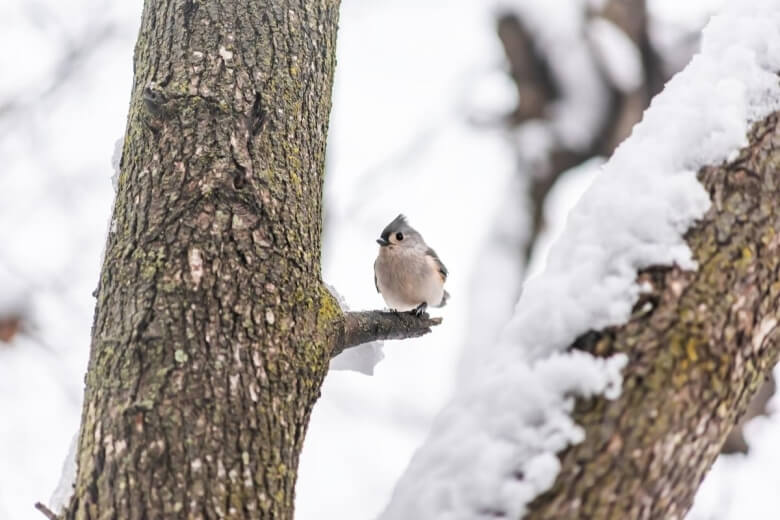
The Tufted Titmice remains in Kansas all year. They are easily identified by their round shape, large head, and unruly crest on top of it. They are gray on top and white on the bottom, with a small black beak and large black eyes with black eyebrows. The sides have a blush-colored streak.
The female looks similar except for a lighter shade of gray, and she lacks the blush. The Tufted Titmice can easily be described as “cute.” A birder who notices chickadees and woodpeckers can assume that a Tufted Titmice is nearby, as they hang out together.
They grow 5.5 to 6.3 inches in length and weigh 0.6 to 0.9 ounces with a wingspan between 7.9 and 10.2 inches. The Tufted Titmice inhabits deciduous and evergreen forests under a 2,000 feet elevation. Insects make up their main diet, but they will also eat nuts, seeds, and berries.
Black Birds in Kansas
Great-tailed Grackles
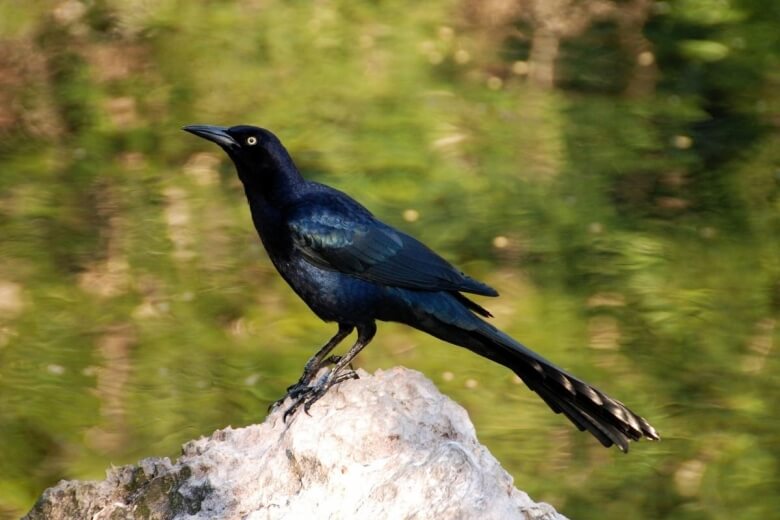
Great-tailed Grackles can be found all year round. The make is all black that has some iridescent blue shining through, with long legs and a sturdy black beak The male stands out with his large, tapered tail and yellow eyes.
The female is half the size of the male, much rounder, with a plain brown head and chest lacking in any sheen. The male grows to 15.0 to 18.1 inches in length and weighs 3.7 to 6.7 ounces with a wingspan between 18.9 and 22.8 inches.
Great-tailed Grackles tend to spend time around people in urban areas and farms and feed on human discards as well as insects, worms, mice, and snakes.
Yellow-headed Blackbird
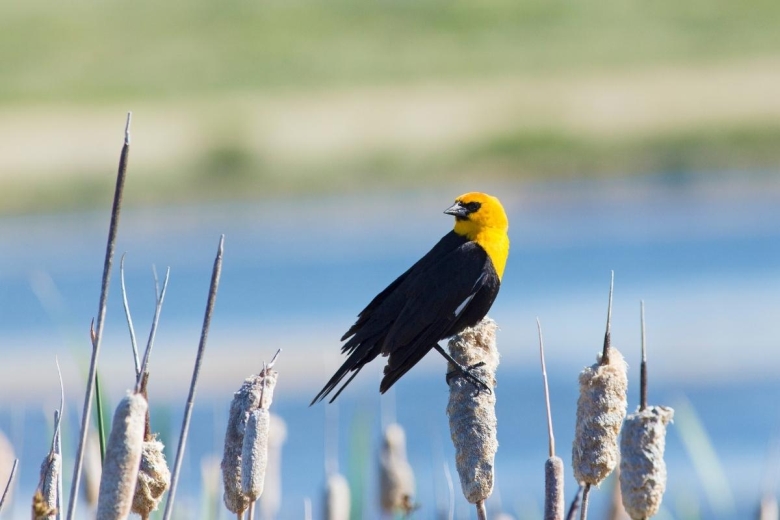
Yellow-headed Blackbird is a common sight at the Quivira Wildlife Refuge. The striking male, all in black with a vivid yellow head and chest and white wing patches, cannot be missed or mistaken for any other bird.
As is normal in the avian world, the female is a duller brown with a just a bit of yellow around the beak. They grow 8.3 to 10.2 inches in length and weigh 1.6 to 3.5 ounces with a wingspan between 16.5 and 17.3 inches. Birds
The Yellow-headed Blackbirds live in wetlands, ponds, and rivers. To find food, they may scatter to any nearby grassland in search of insects and seeds. During the winter, they will forage for food in farm fields and corn fields. When near water, they feed on aquatic insects.
Rusty Blackbird
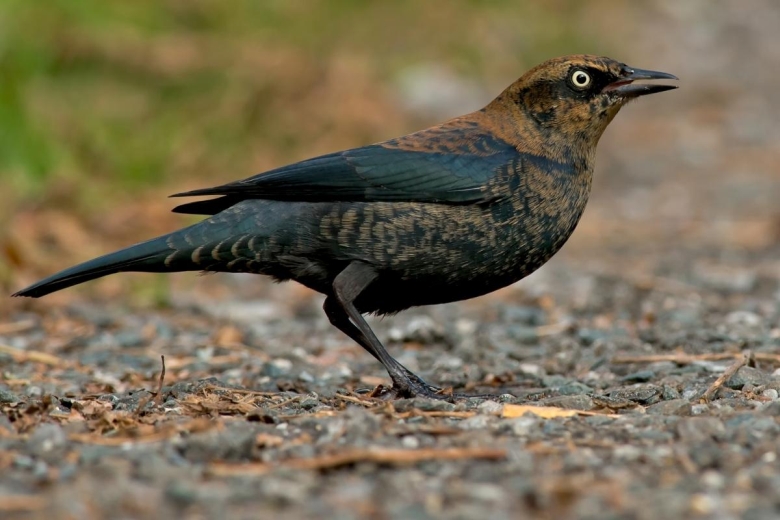
The Rusty Blackbird lives in Kansas from August through November. They have a beautiful black gloss in the summer; in the winter, rusty edges appear on their feathers.
The female has a pale head with the same black rusty-tinged feathers. Both have a thin bill and medium-long tail. They grow 8.3 to 9.8 inches in length and weigh 1.7to 2.8 ounces with a wingspan of 14.6 inches.
They inhabit wetlands, swamps, edges of ponds, and marshes and feed on insects, fruit, acorns, and pine seeds.
Blue Birds in Kansas
The Eastern Bluebird is the State of Kansas’ most common blue bird. This small thrush has a plump body with a large head and long wings. Its bill is straight. The male is a bright blue above with a red throat and chest and a white underside and rump.
Females lean toward gray and blue coloring with a blush-shaded throat and chest instead of deep red. They grow 6.3 to 8.3 inches in length and weigh 1.0 to 1.1 ounces with a wingspan between 9.8 to 12.6 inches.
The Eastern Bluebird can be spotted in meadows, golf courses, fields, and open areas that have trees with nest holes. They feed on insects in the summer and munch on berries in the winter.
Western Bluebird
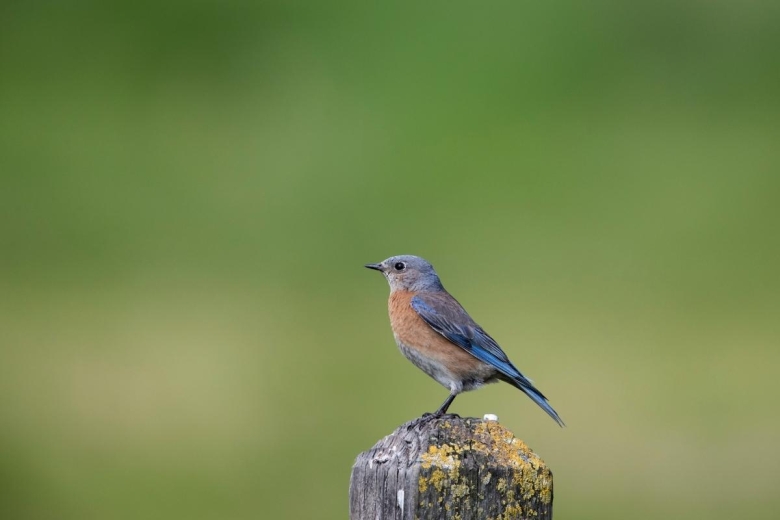
The Western Bluebird can be seen around Southwest Kansas. They are stockier than the Eastern Bluebird with a short bill and long tail. The male is a bright blue with a rusty chest and upper back. The underbelly is white.
The female is a pale shade of tan with a bit of blue on the wings. They grow 6.3 to 7.5 inches in length and weigh 0.8 to 1.1 ounces with a wingspan between 11.4 to 13.4 inches.
The Western Bluebird lives in coniferous and deciduous open woodland, as well as farms and backyards. They will snap up insects and enjoy a variety of berries.
Mountain Bluebird
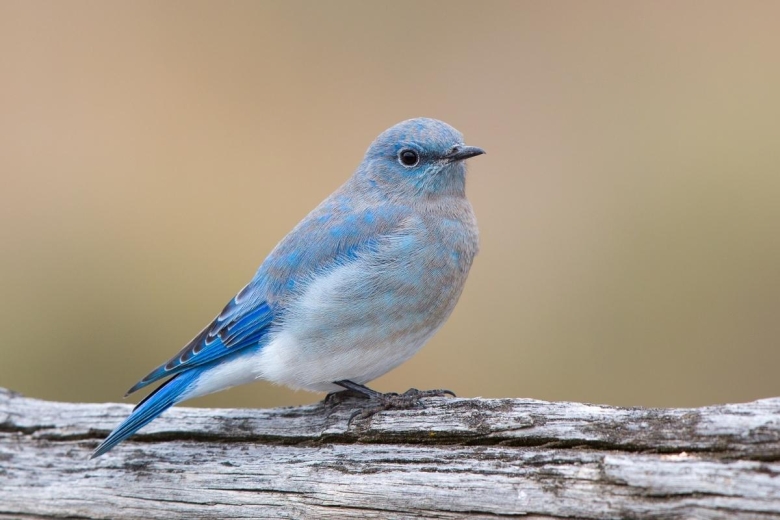
The lovely Mountain Bluebird lives in southwest Kansas during the winter. Like other bluebirds, they have long wings and a long tail. They are sky-blue all over, with a darker blue on the wings and a pale blue belly. Their rump is white.
The female is graying with a few blue tints in the wings and tail. Both their bills are black. This Bluebird grows 6.3 to 7.9 inches in length and weighs 1.1 ounces with a wingspan between 11.0 to 14.2 inches.
The Mountain Bluebird lives in grassy shrubby areas up to 12,500 above sea level. They also look for nesting boxes along roads. They feed on insects and small fruit.
Red Birds in Kansas
House Finch

The House Finch is quite common throughout Kansas all year long. They are small with thick beaks and have short wings and a longish tail. The male has a red head and throat and a lighter, rosy chest, giving him an “ooops, I was bad” blush. The wings and lower belly are a streaky brown. The red rump can be seen when the male is in flight. The female has no red coloring; instead, she has gray and brown streaks all over.
They grow between 5.1 and 5.5 inches in length and weigh 0.6 to 0.9 ounces with a wingspan between 7.9 and 9.8 inches. House Finches inhabit urban parks, farms, and forest edges. They are strict vegetarians and feed on seeds, thistles, fruits, and berries.
Summer Tanager
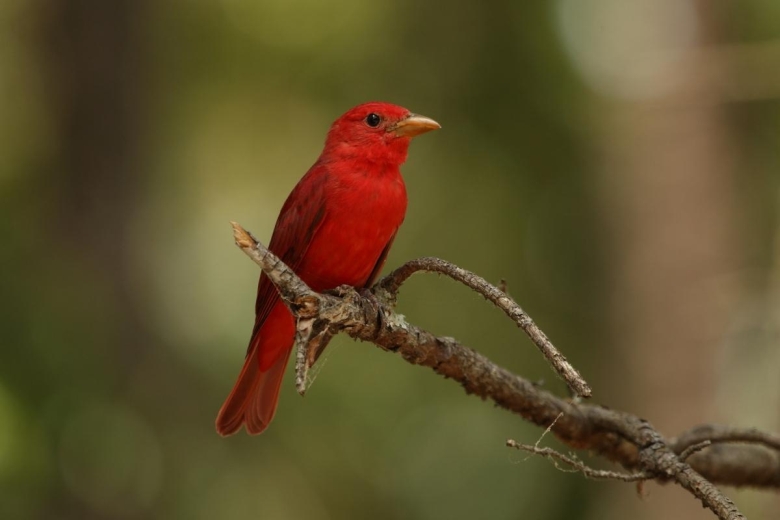
The Summer Tanagers can be seen in eastern Kansas between May and October. They are chunky with a totally red body and a thick, short black beak. The female is yellow-green all over. They grow 6.7 inches in length and weigh 1.1 ounces. They like to live high up in a forest canopy where they snap up insects and are especially fond of bees and wasps, who they will beat against a tree until the stinger falls off. The Summer Tanager will also eat fruit.
Purple Finch

The Purple Finch spends the winter in eastern Kansas. They grow 4.7 to 6.3 inches in length and weigh 0.6 to 1.1 ounces with a wingspan between 8.7 and 10.2 inches. They have been famously referred to as “dipped in raspberry juice,” with brown-streaked wings and a white rump. The female is white and brown-streaked without any raspberry juice.
They spend time in forests and hedgy sites and feed on coniferous seeds, nectar, berries, and insects.
Orange Birds in Kansas
Baltimore Oriole
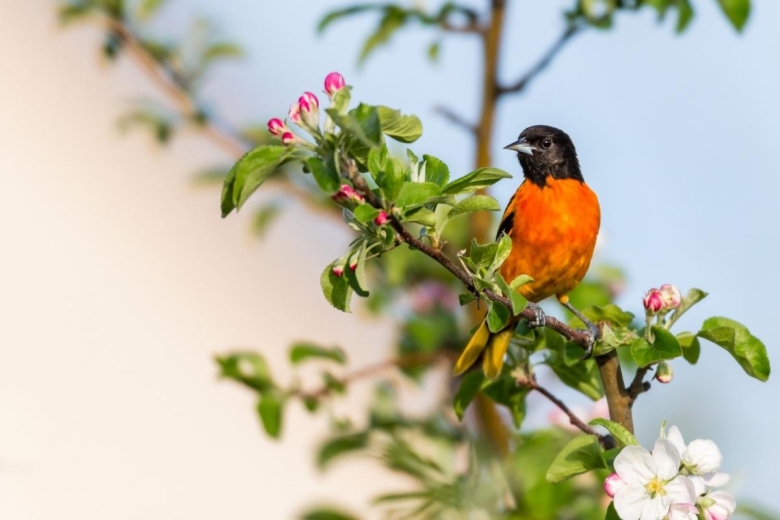
The Baltimore Orioles are quite common in Kansas. They are medium sized with long legs and long, thick bills. They have a black head and black and white striped wings over a bright orange body and tail. The female is a duller, yellowish-gray version of the male. They grow 6.7 to 7.5 inches in length and weigh 1.1 to 1.4 ounces with a wingspan between 9.1 and 11.8 inches.
They live in open woodlands, orchards, and parks, sometimes riverbanks, but they are rarely deep inside a forest. They hunt insects and fruits in shrubby areas. Strangely enough, this orange bird likes orange fruit such as orange slices. On a different color spectrum, the Baltimore Oriole loves grape jelly.
Red-breasted Nuthatch

The Red-breasted Nuthatch inhabits the coniferous forests of Kansas. It is a small bird with an orange chest and a skeptical “what are you up to” expression on its face. They have gray wings with a black and white striped head.
The female looks identical, with the same quizzical expression, except her chest is a paler shade of orange. They grow 4.3 inches in length and weigh 0.3 to 0.5 ounces with a wingspan between 7.1 and 7.9 inches.
Red-breasted Nuthatches feed on insects during the summer. During the winter, they rely on conifer seeds, much of which they have accumulated and stashed throughout the summer. They have a special affinity for spruce budworm when other food becomes scarce.
American Redstart
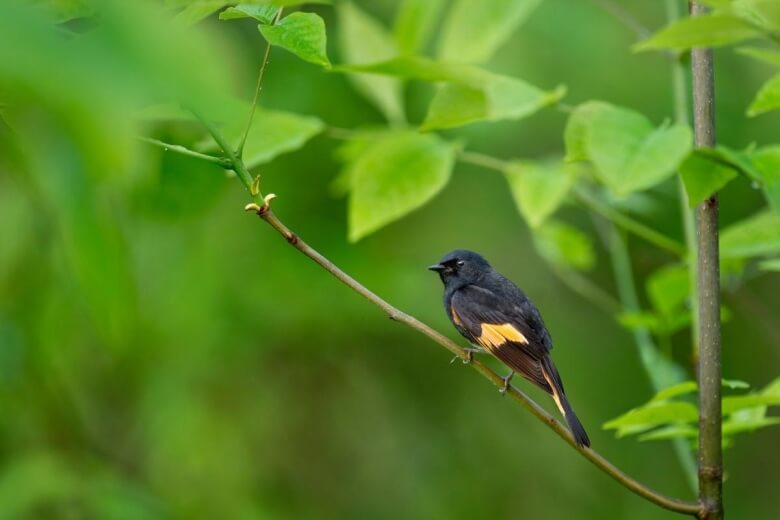
The American Redstart comes to Kanas to breed from May and September. They are black with oranges patches on the breast, wings, and tails. Their underbelly is white. The female is paler, grayer, where the male is black, and pale yellow where he is bright orange.
They grow 4.3 to 5.1 inches in length and weigh 0.2 to 0.3 ounces with a wingspan between 6.3 and 7.5 inches. They live in deciduous woodlands near water and feed on insects they can snap up while jumping from branch to branch. If necessary, they swish their tail to flush out any insect that is hiding.
Yellow Birds in Kansas
Common Yellowthroat
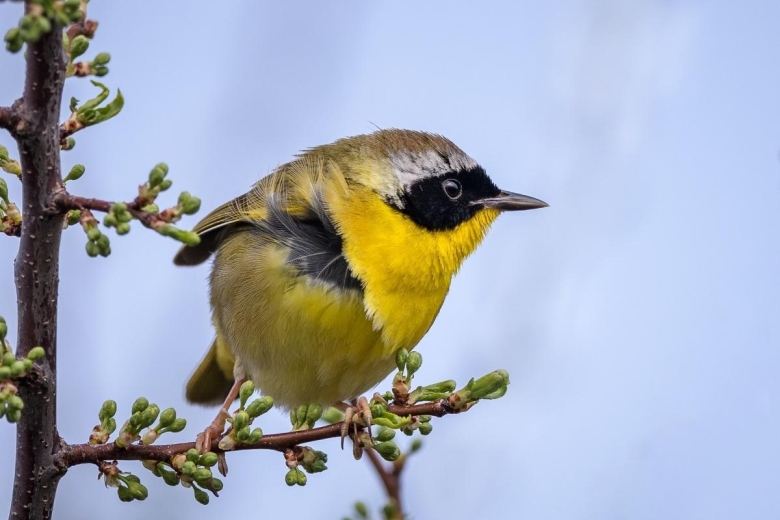
Common Yellowthroats spend April through October in Kansas. They are puffy birds with a bright yellow throat, breast, and under-tail with light brown wings. The female is gray where the male is brown.
The male has a black mask over the eyes with heavy white eyebrows, both of which the female lacks. They grow 4.3 to 5.1 inches in length and weigh 0.3 ounces with a wingspan between 5.9 and 7.5 inches.
They spend time in open areas such as thickets and fields foraging for insects and spiders.
Evening Grosbeak

Birders can find the Evening Grosbeaks in the northern coniferous forests. This large finch is heavyset with a thick beak, neck, and chest. In an interesting approach to color, the male has a yellow belly, yellow shoulders, undertail, and a white back and gray throat. He can easily be identified by the large yellow patch on his forehead.
The female is paler and is mostly white and gray with black wingtips and a hint of yellow through the wings. They grow 6.3 to 7.1 inches in length and weigh 1.9 to 2.6 ounces with a wingspan between 11.8 and 14.2 inches.
They live in deciduous and coniferous trees up to an elevation of 10,000 feet. During the winter, they may hover near bird feeders in search of food. Mostly, they feed on budworms, caterpillars and plenty of seeds.
Yellow-Breasted Chat
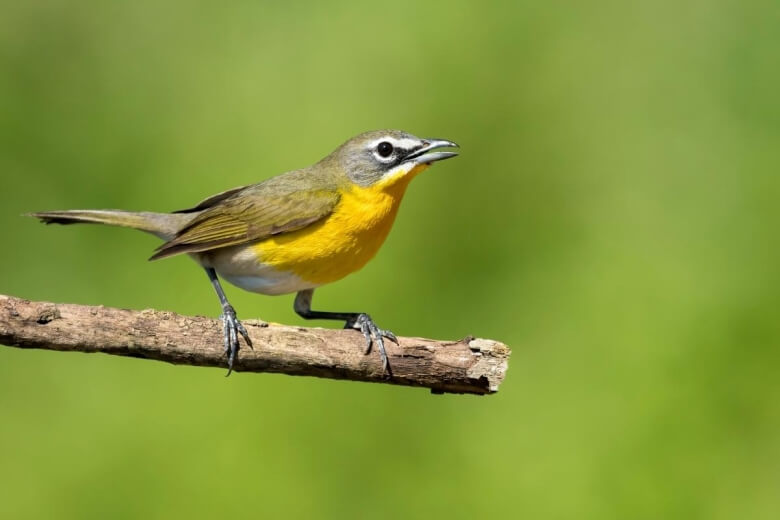
The Yellow-Breasted Chat lives mostly in eastern Kansas. They are small with an incredibly long tail and a fat, stubby beak. Their throat and belly are yellow with a white underbelly and rump. Their wings and head are grayish. The most noticeable thing about their appearance is the large black eyes and the white rim around them.
They grow to 7.1 inches in length and weigh 0.8 to 1.1 ounces with a wingspan of 9.8 inches. Thickets and bushes give them a chance to hide, as do shrubs near streams. They feast on insects and spiders as well as berries of any kind.
Common Bird Species in Kansas
Herons and Egrets in Kansas
Great Blue Heron

The elegant Blue Heron – Ardea Herodias – can usually be found in the shallow waters of Kansas around rivers, lakes, and wetlands. If birds had a beauty contest, the Heron, with its slender build, long legs and long neck would make the final cut. They are shades of blue-gray with a noticeable black strip over the eyes, and their orange bill is long and sharp. They grow 38.2 to 53.9 in length and weigh 74.1 to 88.2 ounces with a wingspan between 65.8 to 79.1 inches.
They thrive near any type of water such as marches, and edges of lakes and rivers and will wade through water in search of food to catch with those amazing large bills. The Great Blue Heron will stab at anything, from fish, and amphibians to small mammals. When in flight, they soar majestically with their long neck tucked into an “S” shape and those long legs sweeping behind them.
American Bittern
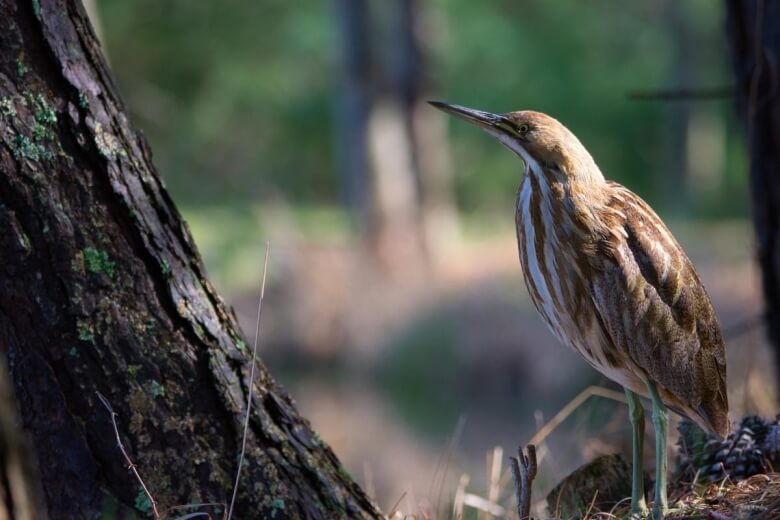
The American Bittern – Botaurus lentiginosus – hovers around the Quivira National Wildlife Refuge. This is a medium-sized heron with short legs and a hunched-over posture. They do have a long, sharp, and straight bill. Their bodies are covered with white and brown streaks. The American Bitterns grow to 23.6 to 33.5 inches in length and weigh 13.1 to 17.6 ounces with a wingspan of 36.2 inches.
They like to spend time in shallow freshwater, hiding within the reeds. The American Bittern hunts insects, fish, crustaceans, and small reptiles. When in water, they remain still, bill pointed downward until they snap up a meal.
Green Heron
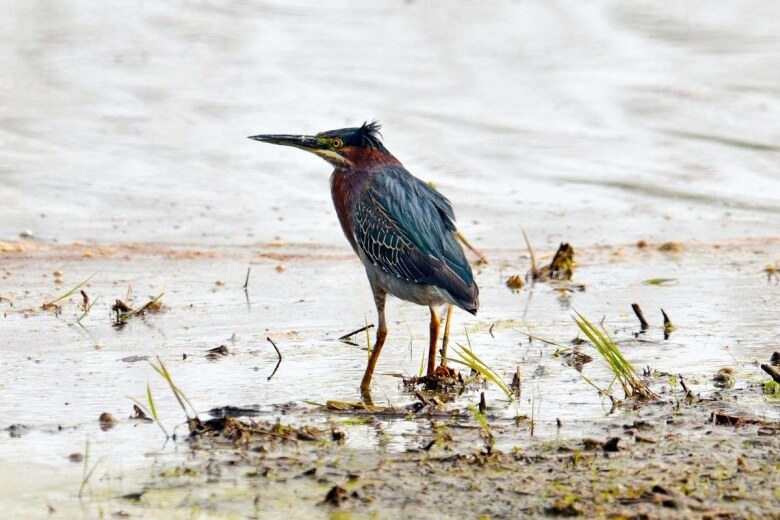
Green Heron – Butorides virescens – inhabits Kansas between April and October. They are a gorgeous color palette of shiny green and black on the back, wings, and head with bright purple breasts and yellow eyes. Their head often has a roguish black crest. Their bill is dark at the top and yellow at the bottom, with their legs ranging from yellow to orange. They often tuck their neck into their body. The Green Heron grows 16.1 to 18.1 inches in length and weighs 25.2 to 26.8 ounces with a wingspan between 25.2 to 26.8 inches.
Like most herons, they live around marshes, ponds, and rivers, where they wade through the water’s edge in search of fish.
Shorebirds in Kansas
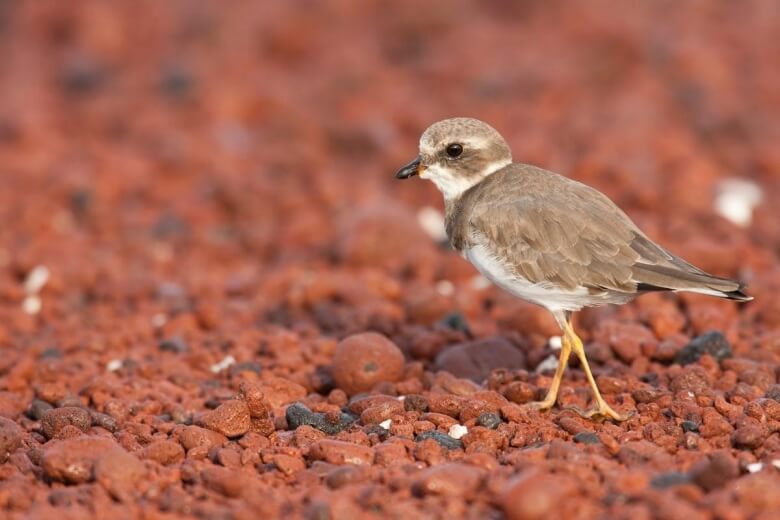
Semipalmated Plover – Charadrius semipalmatus – enjoys open habitats such as beaches, marshes, and golf courses. They are small with a stubby bill and large eyes topped by white eyebrows, with brown coloring above and pale below. They can be identified by a black band around their neck and an orange spot on their beak. The female can be more brown than black. They grow 6.7 to 7.5 inches in length and weigh 1.6 to 1.8 ounces with a wingspan between 18.5 and 19.7.
They nest near water, such as ponds and rivers, and sometimes spend time around fields and golf courses. They mostly feed on invertebrates, crabs, and earthworms and use their feet to startle small creatures to reveal themselves

American Avocet – Recurvirostra americana – spends the winter in Kansas. These lovely shorebirds have long blue-gray legs, a very long upturned bill, and a long neck. Their wings are black with two white bars and a white underbelly. They have a light orangy head, neck, and breasts. The Avocets grow 16.9 and 18.5 inches in length and weigh 9.7 and 12.3 ounces with a wingspan of 28.4 inches.
They inhabit wetlands and salt ponds while wading through water in search of aquatic invertebrates, amphipods, brine flies, and water fleas which they capture by sweeping their bill side to side to startle their prey.

Sanderling – Calidris alba – can be found in most wetlands of Kansas. They are small sandpipers with the usual long bill of shorebirds. They have a white underbelly and an interesting rust, black, and white geometric design everywhere else. Their legs and bills are dark. They grow 7.1 to 7.9 inches in length and weigh 1.4 to 3.5 ounces with a wingspan of 13.8 inches.
They strut the beaches and wait for the receding tide to deposit marine invertebrates, or they dig through the sand in search of crabs, worms, mollusks and other food.
Warblers in Kansas
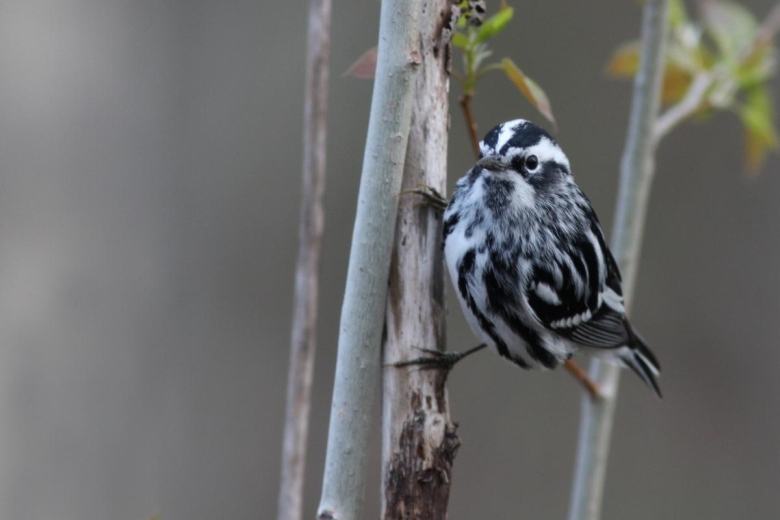
Black-and-White Warbler – Mniotilta varia – is medium-sized with a long, long, downward curving bill. They grow to a length of 4.3 to 5.1 inches and weigh 0.3 to 0.5 ounces with a wingspan between 7.1 and 8.7 inches. They have perfect black and white stripes from head to two, although the female leans more toward gray. During the winter, they will live in gardens, lawns, and urban settings. Their diet consists mostly of moths and butterfly larvae and other insects.
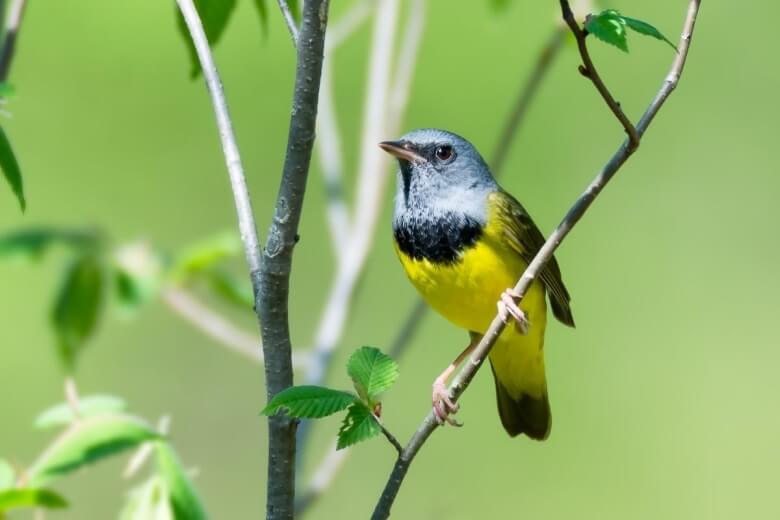
Mourning Warbler – Geothlypis Philadelphia –found in the dense forests of Kansas, is a thickset warbler with a thin bill and long tail. They grow 3.9 to 5.9 inches in length and weigh 0.4 to 0.5 ounces with a wingspan of 7.1 inches. The wings are olive stripes, and the belly is a solid yellow. Their head and throat are gray with black patches. Females are duller shades.
The Mourning Warblers enjoy a shrubby habitat where they can forage on insects and sometimes berries. When they are on the ground, they hop instead of walk, which can make them easier to spot.
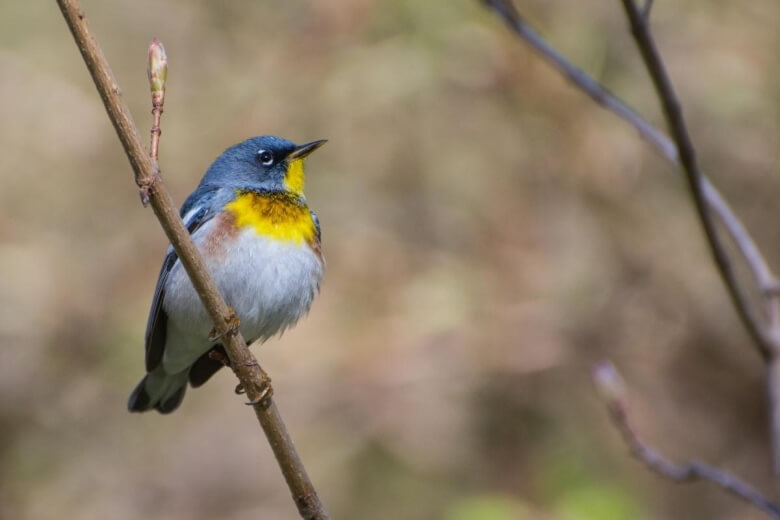
Northern Parula – Setophaga americana – lives in northern Kansas, where it finds the moss it needs to build its nest. They are a short, plumb, and colorful songbird with a blue head and back, yellow neck and chest (which are separated by a dark band), with a white underbelly and short, gray tail. The gray wings have two white bars. They grow 0.2 to 0.4 inches in length and weigh 6.3 to 7.1 ounces with a wingspan between 6.3 to 7.1 inches.
Northern Parulas love the lower parts of deciduous forests near wetlands rather than the high canopies. Wherever they are, however, moss is a necessity for them when they nest. Their primary diet consists of insects, specifically caterpillars. Sometimes, they will eat berries and seeds.
Further Reading on Birding in Kansas
For more information about Kansas birding, consider the following books:
- Used Book in Good Condition
- Tekiela, Stan (Author)
- Used Book in Good Condition
- Tekiela, Stan (Author)
Birders can also check the following sources for more information:

